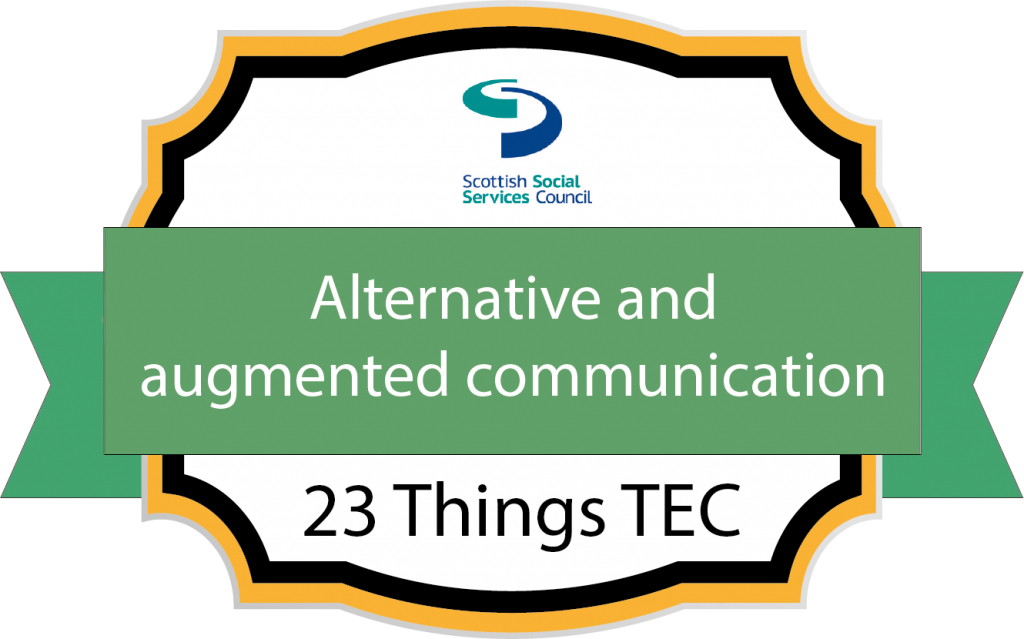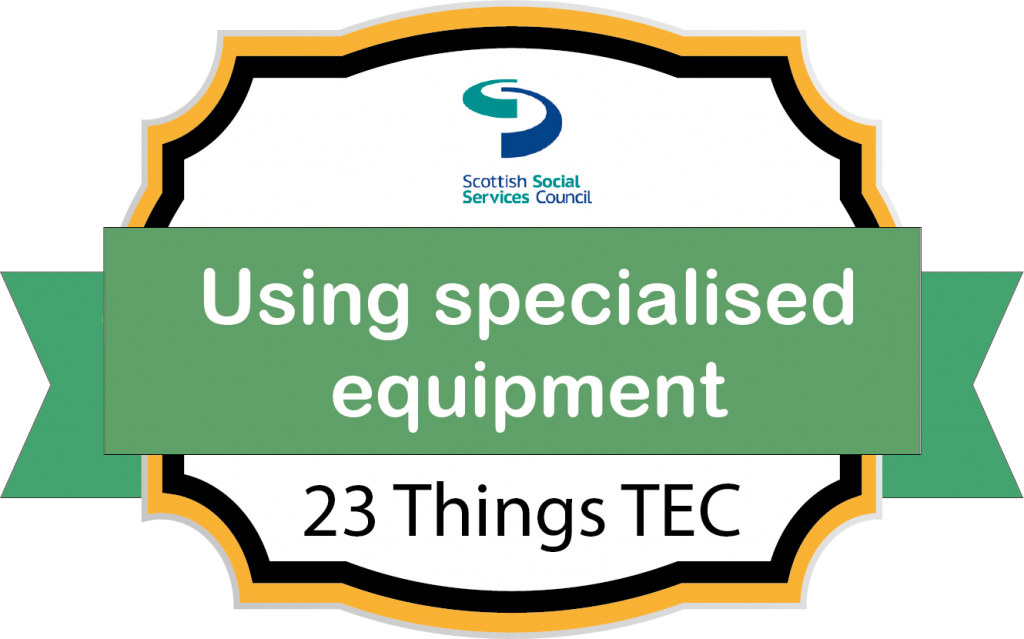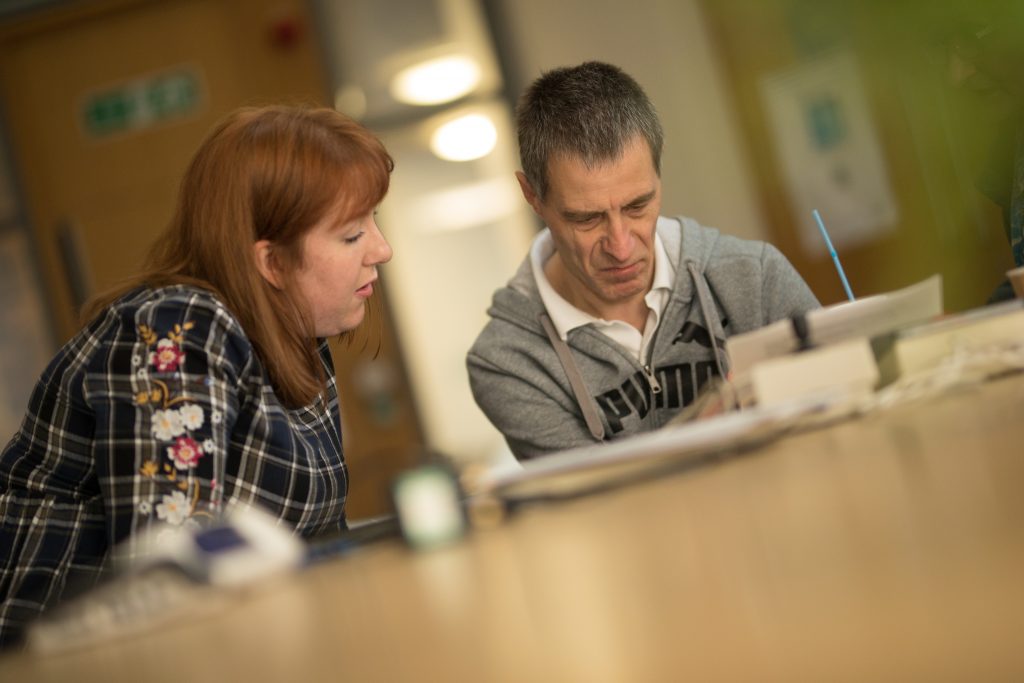The SSSC thanks Rohan Slaughter, Senior Lecturer, Educational Assistive Technology at the University of Dundee for writing all the content below about augmented and alternative communication, and for permission to use the images shown in this.
Open badge information
SSSC 23 Things: Thing 9 ‘Alternative and augmented Communication’.

This counts towards the ‘Using specialised equipment’ badge.

Introduction
AAC or alternative and augmentative communication equipment can be no tech, low tech, or high tech. There are a range of AAC methods and devices that the people you work to support may use. Note that sometimes people may refer to a VOCA (voice output communication aid) or perhaps just to a ‘talker’. In most cases (but not all) they will be referring to an electronic device that produces synthetic speech.
This is how the Communication Matters charity describes AAC:

“Augmentative and Alternative Communication (AAC) is a range of strategies and tools to help people who struggle with speech. These may be simple letter or picture boards or sophisticated computer-based systems. AAC helps someone to communicate as effectively as possible, in as many situations as possible.” (Communication Matters, 2021)
Completing this thing will help you understand more about the different types of AAC.
AAC is an umbrella term that covers a range of communication approaches and equipment. To help you understand this, we have summarised that there are three main types of AAC:
- No-tech
- Low-tech
- High-tech
We will go on to summarise and describe each type of AAC.
No tech
These AAC systems may be used as an individual’s primary method of communication, they may also be used as a backup to a second, possibly higher tech system.
Communication Matters summarises no-tech as follows:
“No-tech communication needs no extra equipment – it is sometimes called “unaided communication”. Examples include body language, gestures, pointing, eye pointing, facial expressions, vocalisations and signing.”
Low-tech
Again these AAC systems may be used as both a primary and secondary method of communication.
Communication Matters summarises no-tech as follows:
“Low-tech communication systems do not need power to function. They are sometimes called “aided communication” because they use basic equipment. Examples include: pen and paper to write or draw; alphabet and word boards; communication charts or books with pictures, photos and symbols; particular objects that represent what someone needs to understand or say.”
Perhaps the most common form of low-tech AAC is the communication book, this takes the form of a printed book that is often laminated or makes use of poly-pocket type bindings. In some cases a communication book may be created using software such as Boardmaker. Indeed some communication books are created by printing out the ‘pages’ or ‘gridsets’ from a high-tech AAC language package such as The Grid 3 from SmartboxAT or Tobii-Dynavox’s Communicator 5.
You may also find that individuals use another similar ‘paper based’ AAC method such as Talking Mats or PECS(Picture Exchange Communication System).
High-tech
High tech AAC systems can be a ‘dedicated device’, meaning that the AAC device was created specifically to be used as an AAC device. Although many AAC devices in use today are based on mainstream tablet technology such as the Apple iPad and Windows based tablets from a variety of manufacturers. Some are also based on the Google Android operating system.
Communication matters summaries high-tech communication systems as follows:
“High-tech communication systems use batteries or mains power. Most gadgets or software speak and/or produce text. Some are based on familiar equipment such as mobile devices, tablets and laptops and may have simple buttons or pages that speak when touched. Very sophisticated systems use equipment specially designed to support communication. Hi-tech communication is also sometimes called “aided communication” because it uses equipment.”
Stored message devices
High tech AAC systems take a number of different forms, including basic ‘stored message’ devices such as the BigMack or the Smooth Talker. A device with a single message is often called a “single message VOCA”. A device with ‘levels’ can also be called a “Message Sequencer VOCA”. These devices use pre-recorded speech, hence the ‘stored message’ name. More complex devices can have multiple stored messages and can have multiple levels, often a printed symbolised paper overlay is put under the buttons to guide the user to a selection. A good example of the more complex stored message devices is the GoTalk32. Such devices are sometimes called “overlay VOCA’s”.
Dynamic screen devices
The dynamic display or screen AAC devices come in a variety of types. We saw above that most are based on mainstream tablets such as the Apple iPad or a Windows or Android tablet. Some are dedicated devices from a specialist supplier such as Tobii-Dynavox, SmartboxAT or Liberator. All dynamic display AAC devices have an operating system (e.g. iPadOS, Windows or Android), an AAC software package or application (e.g. Grid 3 or Communicator 5) and an AAC page set or vocabulary (e.g. SuperCore or WordPower). AAC devices that are based on an Android or Apple tablet may use an App that has both the software package and the page set or vocabulary within it. You can find out more about the range of iPad applications by using the Call Scotland iPad Apps for complex communication support needs resource, this is sometimes known as an ‘app wheel’.
The nature of the page set or vocabulary will change based on:
- The cognitive level of the user
- The age of the user
- The literacy level of the user
- Individual choice and preferences
Even among the dynamic display devices there are a variety of types of AAC language package or page set.
Stored vocabulary devices
Stored vocabulary devices are perhaps the most common high tech AAC system, these organise pages of vocabulary in logical ways, often using folders for specific topics or types of communication. Most now use a ‘core’ approach which starts with the most commonly used words and phrases and makes these most easily and quickly available. Please be aware that the methods by which this is organised or presented can vary based upon the access method, more on this below.
Visual scene displays
Visual scene displays, are less common, and tend to use a photograph or illustration of a scene such as a school classroom or coffee shop etc. to organise the vocabulary.
Semantic compaction
Semantic compaction (also known as Minspeak), is a method that highly literate users may use to chain together words or symbols to produce other words or phrases. It is highly efficient, although it is a demanding (on the user) method of organising AAC language packages.
Other types of AAC
There is more on types of AAC on the Communication Matters website and on the CALL Scotland website.
We do not have space to create an exhaustive list, there are other types of communication aid such as the E-Tran frame, so please do your own research!
Access methods
All high tech AAC devices will require an access method. There are two main types of access method:
- Direct access: Eye-gaze, pointing and pressing
- Indirect access: Switching and Switch scanning
The type of access method an individual uses will need to be carefully chosen based on the users physical and cognitive needs, requirements, and preferences. The access assessment will typically form a part of the AAC assessment.
AAC assessment in Scotland
It is possible for a professional such as a speech and language therapist, occupational therapist, teacher, or assistive technologist to make a referral to a specialist service who can undertake an AAC assessment. In Scotland there is an AAC lead in each health board who is responsible for overseeing clinical AAC services.
You may find the following resources useful in the Scottish AAC context. The following notes are reproduced from the Communication Matters website:
“In 2012, the ‘A Right to Speak’ report was commissioned by the Scottish Government. It contained a number of recommendations which aimed to improve provision and care for individuals who use AAC in Scotland. In 2016, legislation was passed by the Scottish Government which entitled people with communication difficulties to be provided with communication equipment and support. NHS Boards and Integration Joint Boards in Scotland are obligated to fulfil this legislation.
- List of AAC Assessment services serving Scotland
- Download the report ‘A Right to Speak’
- Download the Provision of Communication Equipment and Support Guidance Document
- Download the Easy Read Guidance Document
Learning activities
If you do not support anyone who uses an AAC device, watch Communication Matter’s Roar for AAC video clip on YouTube to learn more about AAC.
- Think about the implications for social service workers and the people they support. You could consider if:
- There is anyone you work with who could benefit from the use of an AAC device, in which case you could ask a suitable professional about how to go about making a referral for an AAC assessment?
- If you are already supporting an AAC user, could you consider:
- If you can learn more about the AAC method or device that they are using?
- Could this help you support them better, for example could you ensure the device was clean, charged and mounted ready for use?
- Are you able to setup the access method properly, (e.g. a head switch or an eye-gaze camera) do you need any help with this?
- Do you need to ask for additional training, perhaps from an organisation such as Call Scotland or Ace Centre?
- Write a blog entry.
- Write a blog post that reflects your thoughts about supporting the use of AAC and detail the ways in which you think having an improved understanding of AAC can support you and your practice.